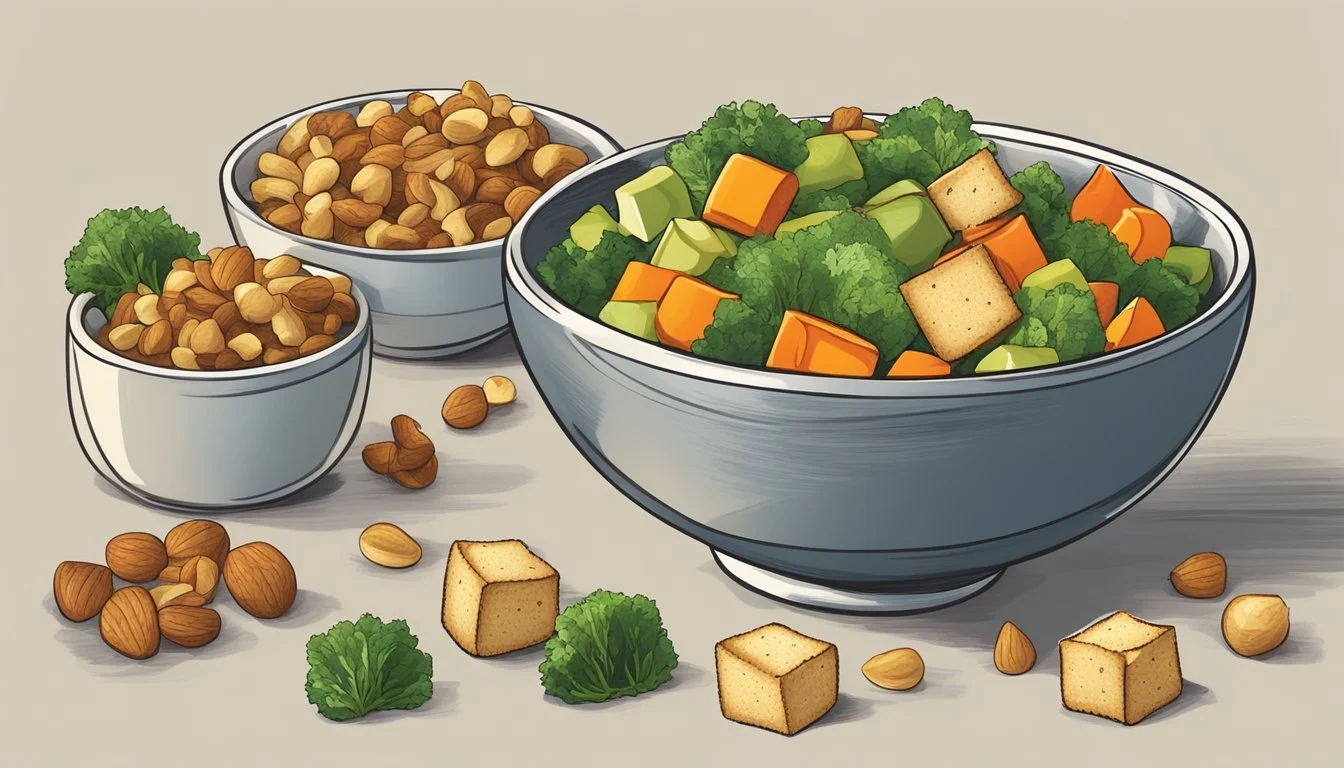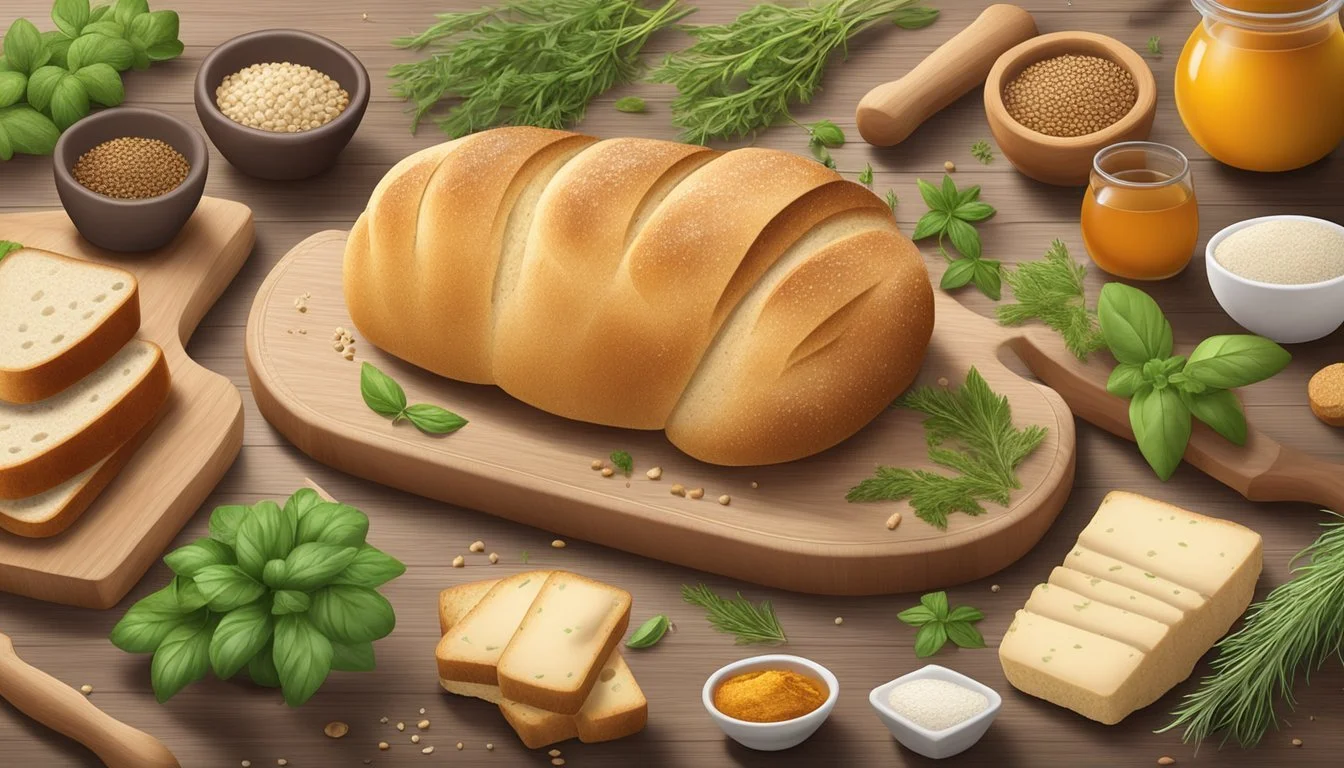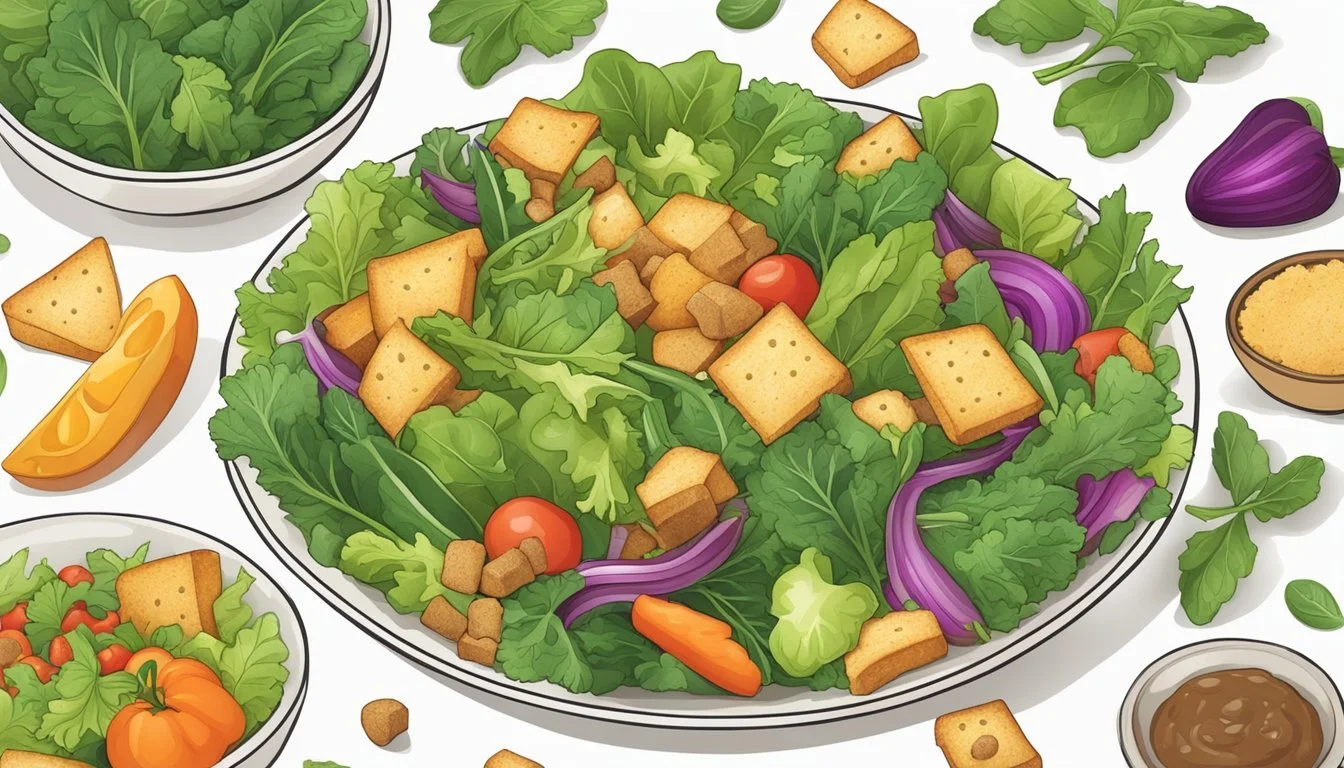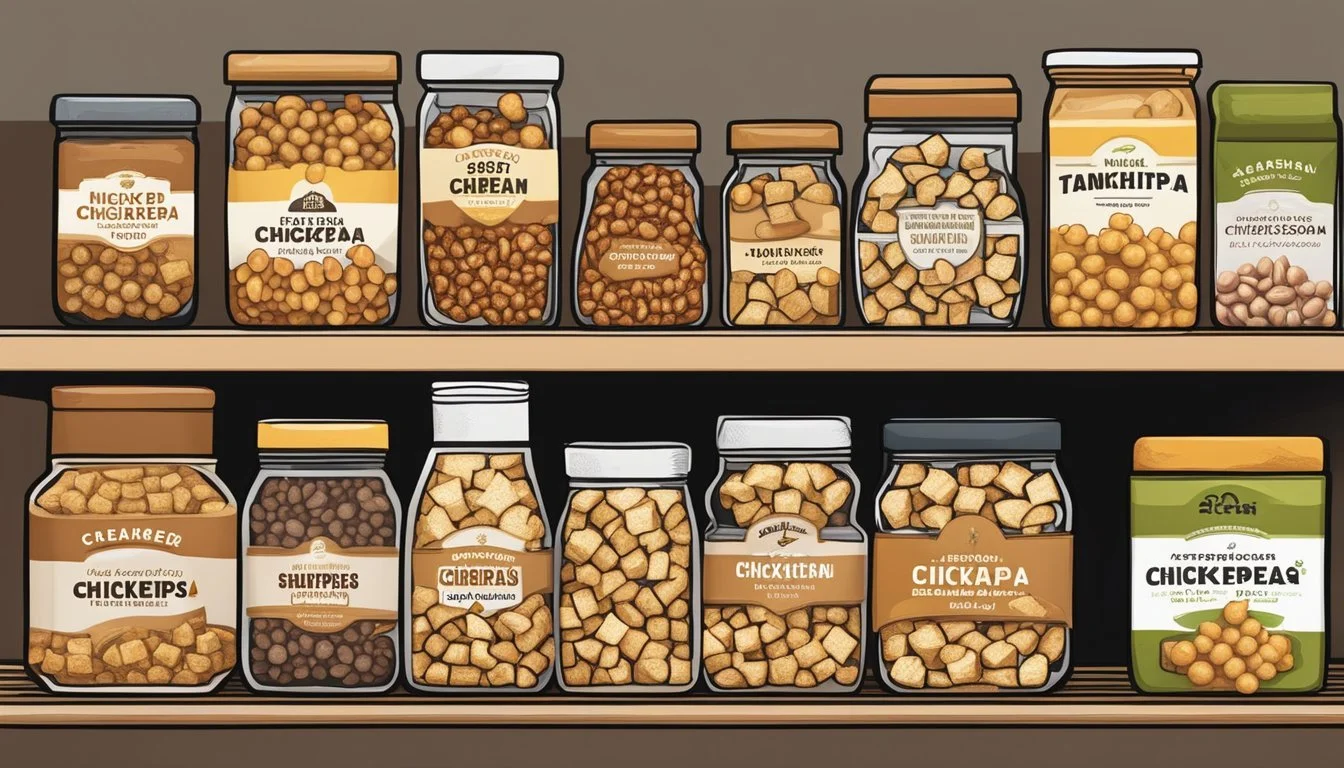Crouton Substitutes
Top Alternatives for Salad Crunch
Crouton substitutes are gaining popularity as individuals look for healthier options to add crunch and flavor to their salads. Traditional croutons, usually made from seasoned, rebaked bread, are loved for their crisp texture, but they often contribute additional refined carbohydrates and can be high in fats depending on their preparation. Seeking alternatives can not only lower the calorie count but also introduce a diversity of nutrients and new flavors to a salad.
In the pursuit of healthier salads, a variety of crouton substitutes have emerged. Options like roasted chickpeas provide a satisfying crunch and come packed with protein and fiber. Nuts and seeds, toasted to perfection, offer a combination of textures and flavors along with healthy fats and essential nutrients. For those looking for lower-calorie alternatives that still deliver on texture, baked zucchini chips or apple chips can be flavorful contenders that complement a wide range of salad ingredients.
In addition to nutritive benefits, these crouton alternatives cater to a breadth of dietary preferences and needs. From gluten-free options like popped quinoa to vegan-friendly choices such as crispy kale, the range of substitutes ensures that salads remain an inclusive dish for virtually any table. Incorporating these alternatives into salads is not only a step towards healthier eating but also an opportunity to elevate the culinary experience with innovative textures and tastes.
Understanding Croutons
Croutons are a common ingredient in salads, known for adding a distinct crunch and flavor. Their role is both functional and nutritional, affecting the overall dining experience.
Role of Croutons in Salads
Croutons serve a significant purpose in salads. They provide a textural contrast to the softness of the greens and other components. The crunch of croutons is particularly valued as it adds a sensory variety to each bite. Additionally, croutons carry flavor, offering an opportunity to incorporate various seasonings and tastes into a salad. They can also act as a carrier for fats, such as oils or butter, which are often used in their preparation, contributing to the overall flavor profile of the dish.
Nutritional Profile of Traditional Croutons
The nutritional aspect of traditional croutons is relatively straightforward. Typically made from white bread, they are toasted or fried with fats like oil or butter. Here is a brief overview of their nutritional content:
Calories: Croutons are calorie-dense due to the combination of bread and fats.
Carbohydrates: As a bread-based item, they are high in carbohydrates.
Fats: The oils or butter used in preparation contribute to the fat content of croutons.
Proteins: They offer minimal protein.
Fiber: Depending on the type of bread used, they may lack significant dietary fiber.
The use of whole-grain bread can improve the nutritional value by providing more fiber and potentially reducing the croutons' impact on blood sugar levels. On the flip side, traditional croutons can be high in sodium and may contain preservatives, depending on the commercial brand.
Health-Conscious Alternatives
When searching for healthier crouton substitutes, one should consider their nutritional benefits, such as fiber and protein content, and how they might add to the existing flavors and textures of a dish.
Oven-Baked Veggie Chips
Kale chips offer a low-calorie, fiber-rich alternative to traditional croutons. One can easily make them at home by tossing fresh kale leaves in a small amount of olive oil, seasoning with salt, and baking until crisp. Similarly, chips made from root vegetables like sweet potatoes can contribute a satisfying crunch with additional health benefits.
Nuts and Seeds
Nuts and seeds provide an excellent source of protein and healthy fats. Pumpkin seeds, for instance, can be toasted with a drizzle of olive oil and a sprinkle of sea salt to create a crunchy salad topping. Almonds and walnuts, pan-toasted until fragrant, also make hearty, nutritious additions to any salad.
Legume-Based Options
Legumes are versatile crouton substitutes rich in protein and fiber. Take roasted chickpeas, for example, that can be seasoned and crisped up in the oven. They add not just a crunch but also a boost of nutrition. These can come in various flavors, such as garlic or cayenne, giving a new dimension to the dish they complement.
Cheese-Inspired Options
When looking for crouton substitutes, cheese provides a range of flavors and textures that can elevate a salad or a soup. Cheese options vary in taste from mild and creamy to sharp and complex, offering a satisfying crunch and rich flavor profile.
Parmesan Crisps
Parmesan crisps offer a delightful crunch and a rich, savory flavor that can serve as an excellent replacement for croutons. These crisps are made by baking small mounds of grated Parmesan cheese until they turn golden and crisp. Not only do they add a textural contrast, but their intense flavor enhances salads and soups (What wine goes well with soups?) much like croutons would.
Aged Cheese Flavors
For those preferring deeper, more complex flavors, aged cheeses such as cheddar provide a robust alternative.
Aged Cheddar: Its sharpness can mimic the hearty edge that croutons bring to dishes.
Texture: Aged cheeses can be baked into small, bite-sized pieces that mimic the crunch of croutons.
Flavor Pairing: The rich flavors work well with a variety of salads, especially those with bitter greens or sweet dressings, balancing the overall taste.
By incorporating these cheese-inspired options, one can successfully replace traditional croutons with something just as satisfying.
Bread Alternatives
When seeking crouton substitutes for salads and soups, bread alternatives offer a diverse range of taste and texture. These options cater to varying dietary restrictions and health needs, providing a straightforward solution for adding a satisfying crunch.
Whole Grain Options
Whole grain breads are an excellent source of dietary fiber and nutrients. For a hearty replacement to traditional croutons, one may opt for whole grain homemade croutons. To prepare these, simply cube your choice of whole grain bread, toss with a bit of olive oil and your preferred seasonings, and bake until crispy. This creates a satisfying crunch, rich in flavor and nutritional value.
Gluten-Free Selections
Individuals with gluten sensitivities or celiac disease can turn to gluten-free bread options to create their crouton alternatives. Gluten-free bread can be found in most supermarkets or baked at home using gluten-free flours. Much like their whole grain counterparts, gluten-free bread cubes can be seasoned and toasted, offering a similar textural element to dishes that would usually include croutons. It's important to ensure that all other ingredients used are also free of gluten to prevent cross-contamination.
Savory and Spicy Substitutes
For those seeking to infuse their meals with piquant flavors and satisfying crunch, the world of savory and spicy crouton substitutes offers a variety of delightful alternatives. These options not only complement the textures found in salads but also introduce an array of complementary flavors.
Roasted Chickpeas
Roasted chickpeas serve as a perfect crouton substitute, bringing a salty and savory profile with the option to tailor the spiciness to one's taste. A high-protein, fiber-rich option, chickpeas can be tossed with olive oil, salt, and spices such as cumin and roasted until crispy.
Preparation: Coat chickpeas in a light layer of olive oil and seasonings.
Cooking: Spread on a baking sheet and roast at 400°F (200°C) until golden and crunchy.
Customizing Flavor: Adjust the level of spices, including cumin, for a personalized kick.
Spiced Nuts
Nuts offer a hearty texture and rich flavor as an alternative to traditional croutons. When toasted and tossed with a fusion of spices, they provide a spicy and salty bite that enhances the overall dish.
Options: Almonds, walnuts, or pecans are excellent choices.
Spicing Technique: Coat lightly in oil, sprinkle with sea salt, cumin, and optional chili powder, then toast.
Benefits: Nuts are full of healthy fats and protein, contributing to a more nutritious meal.
By incorporating these substitutes, salads and soups gain a flavorful edge that traditional croutons cannot match. Roasted chickpeas and spiced nuts offer versatile and health-conscious alternatives that can be tailored to suit a range of diverse palates.
Sweet Crouton Substitutes
Substituting traditional croutons with sweet alternatives is an excellent way to incorporate unique flavors into salads or desserts. These light, sugary options add a pleasant contrast to the usual savory or tart components.
Fruit-Based Toppings
Dried fruits such as raisins, cranberries, and cherries are popular choices for a sweet crunch. They bring a natural sweetness and chewiness, offering a burst of flavor that complements leafy greens.
Cranberries: Tart and slightly sweet, adds a vibrant pop of color.
Raisins: Known for their concentrated sweetness and texture.
Cherries: Offer a juicy, tangy note that can elevate the overall taste profile.
Pairing these dried fruits with mixed greens or a spinach salad can bridge the gap between sweet and savory, creating a harmonious balance within the dish.
Sweet Granola Clusters
Granola clusters made with oats, nuts, and a variety of sweeteners can serve as a crunchy addition to salads or yogurts. They bring a toasted, sweetened taste that mimics the crispness of croutons.
Sweetened Granola: Typically baked with honey, maple syrup, or brown sugar for a delightful crunch.
Kettle Corn Granola: Incorporates kettle corn's signature sweet and salty profile for a unique twist.
Using these granola options not only adds texture but also increases the nutrient content of the dish, offering fibers and proteins. Carefully baked to achieve a golden hue, granola clusters can add both visual appeal and a satisfying bite to any recipe.
Unique Flavor Additions
When seeking to enhance salads with creative twists, one's choice of crouton substitutes can bring a delightful array of unique flavors to the dish. These alternatives not only complement the existing ingredients but also introduce new taste profiles that can elevate a simple salad to a culinary experience.
Herb-Infused Options
Herb-infused crouton replacements offer a distinctive and aromatic edge to salads. For a vegan choice, roasted chickpeas can be tossed with a blend of sea salt, black pepper, and herbs like rosemary or thyme. The result is a crunchy element with a rustic, earthy flavor profile that pairs exceptionally well with greens.
Exotic Toppings
To inject an adventurous flavor into salads, exotic toppings play a crucial role. Toasted seeds like pumpkin or sunflower can be mixed with spices like sriracha for a bold kick. This not only adds a nutty crunch but also provides an exciting heat that can transform an ordinary salad. Experimentation with different seasonings allows for a unique experience in every bite.
Customizing Crouton Substitutes
Crouton substitutes offer a versatile way to enhance salads with added texture and flavor. Through homemade recipes and specific seasonings, one can tailor these alternatives to satisfy individual tastes and dietary preferences.
Homemade Recipes
Creating crouton substitutes at home gives one control over ingredients and ensures that nutritional benefits are not overlooked. For those seeking a protein-rich addition, roasted chickpeas can be a savory choice. They can simply toss the chickpeas with olive oil and seasonings before baking. Another option is baking thinly sliced zucchini chips, which provide a low-carbohydrate alternative with a satisfying crunch.
Roasted Chickpeas:
Preheat oven to 400°F (204°C).
Rinse and drain chickpeas, coat with olive oil and spices.
Bake for 15-20 minutes until crisp.
Zucchini Chips:
Slice zucchini thinly.
Season, drizzle with oil, and bake at a low temperature until crispy.
Seasoning to Taste
The flavor of crouton substitutes can be customized with a variety of seasonings. Sesame seeds can be added to give a nutty taste and a slight crunch. Seasonings such as garlic powder, smoked paprika, and freshly ground black pepper enhance the taste profile of substitutes like roasted nuts or seeds. One must always season to taste, ensuring not to overpower the main ingredients of the dish.
For a Nutty Flavor:
Sprinkle sesame seeds on substitutes such as roasted almonds or baked pita chips.
For a Savory Flavor:
Combine garlic powder, smoked paprika, and black pepper; toss with homemade substitutes before baking.
Brands and Store-Bought Alternatives
In the world of croutons, consumers have a myriad of store-bought options, encompassing both widely recognized brands and specialty alternatives. These products offer a conveniet way to add crunch and flavor to salads and soups.
Pre-Packaged Choices
Major brands like Rothbury Farms and 365 Whole Foods Market are staples in the crouton aisle, with Rothbury Farms offering a fat-free seasoned variety that caters to those mindful of their fat intake. Meanwhile, 365 Whole Foods Market emphasizes organic ingredients with its seasoned croutons. Store brands such as Kroger allow for budget-friendly purchases without compromising on taste. For vegan consumers, selecting vegan-marked packages like those with plain plantains croutons promise compatibility with their dietary preferences.
Rothbury Farms: Offers a fat-free seasoned option.
365 Whole Foods Market: Organic seasoned croutons for a wholesome choice.
Kroger: Affordable and flavorful, available in the Kroger chain of stores.
Specialty Brands
Specialty alternatives convey uniqueness through their ingredients and the culinary experience they provide. For example, substitutes like roasted chickpeas, zucchini chips, and Parmesan crisps serve as innovative replacements that cater to various dietary needs and preferences.
Roasted chickpeas: A protein-rich, gluten-free alternative to traditional croutons.
Zucchini chips: A low-carb, crispy option ideal for those on special diets.
Parmesan crisps: Offer a keto-friendly crunch with a cheesy flavor profile.
Each of these substitute brands proposes a twist on the classic crouton, allowing consumers to customize their dishes to their particular taste and dietary requirements. Whether one is seeking vegan alternatives or gluten-free options, the market provides a diverse selection to elevate any culinary creation.
Incorporating Substitutes into Meals
Substitutes for traditional croutons offer a diverse range of textures and flavors to meals. Rather than relying on the standard bread croutons, one can enhance their dishes with alternative toppings that may also align with dietary preferences such as gluten-free or lower calorie options.
Salad Topping Ideas
Salads benefit greatly from a variety of textures and flavors. One can easily uplift a typical Caesar salad by substituting traditional croutons with alternatives such as:
Pita Chips: These bring a Mediterranean twist and are often seasoned with herbs like oregano and thyme.
Roasted Chickpeas: Offering a hearty crunch, chickpeas can be spiced to preference making them a protein-rich topping.
Toasted Nuts: Almonds or walnuts offer a nutritious crunch and are pleasing when toasted to elevate their natural oils.
For those preferring a cheesy addition, Parmesan crisps serve as a low-calorie, gluten-free option that melds seamlessly with the creaminess of Caesar dressing. Another innovative topping is crispy bacon bits, which can add a smoky flavor to the salad.
Beyond Salads: Other Dishes
The versatility of crouton substitutes extends beyond salads into a range of other dishes including soups and casseroles. In soups, for instance, where bread croutons might become soggy, alternatives can maintain their texture better and add to the dining experience. Consider the following options:
Polenta Croutons: Cubed and roasted polenta can provide a satisfying chew in a warm bowl of soup.
Zucchini Chips: These offer a delicate, yet crisp addition ideal for lighter soups.
Each substitute has the potential to not only complement but elevate the main dish's flavors and textures, adhering to dietary needs without compromising on taste.









